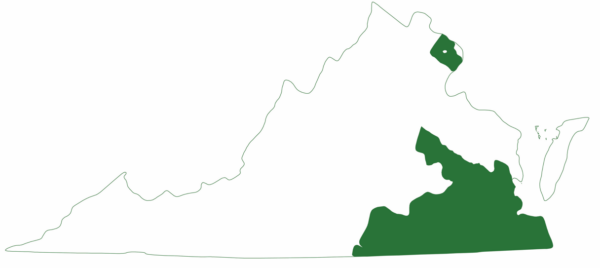Fact File
Scientific Name: Trachemys scripta scripta
Classification: Reptilia, Order Testudines, Family Emydidae
Conservation Status:
- Species of Greatest Conservation Need-Tier 4b on the Virginia Wildlife Action Plan
Size: Up to 12.2 inches in length
Identifying Characteristics
This is a large freshwater turtle reaching a maximum carapace length of 11.4 inches in the U.S. The carapace (upper shell) is oval, weakly keeled, and olive to brown with yellow markings. Old individuals may be completely black. The rear margin of the carapace is serrated. The plastron (lower shell) is yellow with black markings; usually there are two solid black spots on the rear plastron. There is a vertical yellow line behind the eye and stripes on the neck, arms, and legs. Eggs and nesting females have been found from May through July. There are usually from 10 to 12 eggs, although larger females may lay more. The newly-hatched young remain in the nest until heavy rains loosen the encrusted soil. Mating occurs in spring, fall, and winter months. The activity period is April through October.
Habitat
This turtle is frequently observed basking on banks or logs. These turtles overwinter in water in soft organic substrate, in muskrat burrows, and by simply sitting on the bottom. The Yellow-bellied Slider naturally ranges from central to southeastern Virginia and west to the Roanoke River basin, with introduced populations occurring in northern Virginia. They occur in a variety of permanent and semi-permanent freshwater habitats.
Distribution:
Trachemys scripta scripta is found in southeastern Virginia in the lower York County-James City County peninsula and south of the James River from the Atlantic Coast westward into Lunenburg and Mecklenburg counties. It inhabits a wide variety of freshwater habitats in southeastern Virginia, from lakes and ponds, to rivers, ditches, marshes, bays, and swamps, and will sometimes enter brackish or salt water. It prefers sites that have an organic substrate, aquatic vegetation, and basking sites.

Last updated: March 19, 2025
The Virginia Department of Wildlife Resources Species Profile Database serves as a repository of information for Virginia’s fish and wildlife species. The database is managed and curated by the Wildlife Information and Environmental Services (WIES) program. Species profile data, distribution information, and photography is generated by the Virginia Department of Wildlife Resources, State and Federal agencies, Collection Permittees, and other trusted partners. This product is not suitable for legal, engineering, or surveying use. The Virginia Department of Wildlife Resources does not accept responsibility for any missing data, inaccuracies, or other errors which may exist. In accordance with the terms of service for this product, you agree to this disclaimer.

